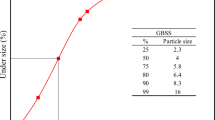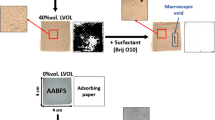Abstract
This work evaluates the application effect and mechanism of superplasticizers (SPs) in alkali-activated materials (AAM). Naphthalene superplasticizer (NS), aliphatic superplasticizer (AS) and polycarboxylate superplasticizer (PS) were selected, and three aluminosilicate precursors and two alkali activators were used to prepare AAM. The results showed that all three SPs cannot effectively improve the fluidity of AAM paste, but have certain plasticizing effect in AAM mortar. Both the molecular structure and absorption property of the three SPs changed in AAM. The activator NaOH had more serious damage to the molecular structure of SPs, while the competitive adsorption of Na2SiO3 to SPs was more intense. The intrinsic viscosity and infrared spectrum characteristic peak of AS were relatively stable, followed by NS, while the PS molecule was the most unstable in the alkaline environment. For precursors, metakaolin had the highest surface adsorption energy, resulting in its winding with the incomplete SPs molecule damaged by activator and a decrease in paste fluidity. For fly ash with a smooth surface and low calcium content, its absorption capacity to SPs was the worst, having the smallest adsorption layer thickness of SPs and |ζ| potential. Although the slag could form effective absorption with the anion of SPs, there was significant competition for calcium ions between the SPs and activators, causing the detachment of SPs from the slag surface.











Similar content being viewed by others
References
Xiao H, Zhang F, Miao L et al (2020) Long-term trends in Arctic surface temperature and potential causality over the last 100 years[J]. Clim Dyn 55:1–14
Andrew RM (2018) Global CO2 emissions from cement production, 1928–2017[J]. Earth Syst Sci Data 10(4):2213–2239
Shi C, Jiménez AF, Palomo A (2011) New cements for the 21st century: the pursuit of an alternative to Portland cement[J]. Cem Concr Res 41(7):750–763
Deetman S, Marinova S, Van Der Voet E et al (2020) Modelling global material stocks and flows for residential and service sector buildings towards 2050[J]. J Clean Prod 245:118658
Guiding opinions on comprehensive utilization of bulk solid Wastes during the "Fourteenth Five Year Plan
Chu Z, Wang W, Zhou A et al (2019) Charging for municipal solid waste disposal in Beijing[J]. Waste Manag 94:85–94
Aprianti E (2016) A huge number of artificial waste material can be supplementary cementitious material (SCM) for concrete production a review part II[J]. Journal of Cleaner Production p S0959652616000305
Juenger M, Bernal SA, Snellings R (2019) Supplementary cementitious materials: new sources, characterization, and performance insights[J]. Cem Concr Res 122:257–273
Chindaprasirt P, Chareerat T, Sirivivatnanon V (2007) Workability and strength of coarse high calcium fly ash geopolymer[J]. Cement Concr Compos 29(3):224–229
Nematollahi B, Sanjayan J (2014) Effect of different superplasticizers and activator combinations on workability and strength of fly ash based geopolymer[J]. Mater Des 57:667–672
Bakharev T, Sanjayan JG, Cheng YB (2000) Effect of admixtures on properties of alkali-activated slag concrete[J]. Cem Concr Res 30(9):1367–1374
Palacios M, Puertas F (2005) Effect of superplasticizer and shrinkage-reducing admixtures on alkali-activated slag pastes and mortars[J]. Cem Concr Res 35(7):1358–1367
Ruan S, Chen S, Zhu X et al (2021) Matrix wettability and mechanical properties of geopolymer cement-polydimethylsiloxane (PDMS) hybrids[J]. Cem Concr Compos 124:104268
Provis JL, Palomo A, Shi C (2015) Advances in understanding alkali-activated materials[J]. Cem Concr Res 78:110–125
Zhang Z, Zhu Y, Yang T et al (2017) Conversion of local industrial wastes into greener cement through geopolymer technology: a case study of high-magnesium nickel slag[J]. J Clean Prod 141:463–471
Davidovits J (1989) Geopolymers and geopolymeric materials[J]. J Therm Anal 35:429–441
Aiken TA, Sha W, Kwasny J et al (2017) Resistance of geopolymer and Portland cement based systems to silage effluent attack[J]. Cem Concr Res 92:56–65
Kong DLY, Sanjayan JG (2010) Effect of elevated temperatures on geopolymer paste, mortar and concrete[J]. Cem Concr Res 40(2):334–339
Singh B, Ishwarya G, Gupta M et al (2015) Geopolymer concrete: a review of some recent developments[J]. Constr Build Mater 85:78–90
Provis JL, Bernal SA (2014) Geopolymers and related alkali-activated materials, clarke DR, editor. Annu Rev Mater Res 44:299–327
Puertas F, Varga C, Alonso MM (2014) Rheology of alkali-activated slag pastes. effect of the nature and concentration of the activating solution[J]. Cem Concr Compos 53:279–288
Rakngan W, Williamson T, Ferron RD et al (2018) Controlling workability in alkali-activated class C fly ash[J]. Constr Build Mater 183:226–233
Hallal A, Kadri EH, Ezziane K et al (2010) Combined effect of mineral admixtures with superplasticizers on the fluidity of the blended cement paste[J]. Constr Build Mater 24(8):1418–1423
Morin V, Tenoudji FC, Feylessoufi A et al (2001) Superplasticizer effects on setting and structuration mechanisms of ultrahigh-performance concrete - ScienceDirect[J]. Cem Concr Res 31(1):63–71
Robert CR, Sathyan D, Anand KB (2018) Effect of superplasticizers on the rheological properties of fly ash incorporated cement paste-sciencedirect[J]. Mater Today Proceed 5(11):23955–23963
Sun Z, Liu H, Ji Y et al (2020) Influence of glycerin grinding aid on the compatibility between cement and polycarboxylate superplasticizer and its mechanism[J]. Constr Build Mater 233:117104
Douglas E, Brandstetr J (1990) A preliminary study on the alkali activation of ground granulated blast-furnace slag[J]. Cem Concr Res 20(5):746–756
Criado M, Palomo A, Fernández-Jiménez A et al (2009) Alkali activated fly ash: effect of admixtures on paste rheology[J]. Rheol Acta 48(4):447–455
Conte T, Plank J (2019) Impact of molecular structure and composition of polycarboxylate comb polymers on the flow properties of alkali-activated slag[J]. Cem Concr Res 116:95–101
Jang JG, Lee NK, Lee HK (2014) Fresh and hardened properties of alkali-activated fly ash/slag pastes with superplasticizers[J]. Constr Build Mater 50:169–176
Luukkonen T, Abdollahnejad Z, Ohenoja K et al (2019) Suitability of commercial superplasticizers for one-part alkali-activated blast-furnace slag mortar[J]. J Sustain Cem-Based Mater 8(4):244–257
Memon FA, Nuruddin MF, Demie S et al (2012) Effect of superplasticizer and extra water on workability and compressive strength of self-compacting geopolymer concrete[J]. Res J Appl Sci Eng Technol 4(5):407–414
Hardijito D, Wallah SE, Sumajouw DMJ et al (2004) On the development of fly ash-based geopolymer concrete[J]. ACI Mater J 101(6):467–472
Palacios M, Houst YF, Bowen P et al (2009) Adsorption of superplasticizer admixtures on alkali-activated slag pastes[J]. Cem Concr Res 39(8):670–677
Carabba L, Manzi S, Bignozzi MC (2016) Superplasticizer addition to carbon fly ash geopolymers activated at room temperature[J]. Materials 9(7):586
Mohamed AK, Weckwerth SA, Mishra RK, Heinz H, Flatt RJ (2022) Molecular modeling of chemical admixtures; opportunities and challenges[J]. Cem Concr Res 156:106783
Liao Y, Zheng H, Qian L et al (2014) UV-initiated polymerization of hydrophobically associating cationic polyacrylamide modified by a surface-active monomer: a comparative study of synthesis, characterization, and sludge dewatering performance[J]. Ind Eng Chem Res 53(27):11193–11203
Yilmaz VT, Kindness A, Glasser FP (1992) Determination of sulphonated naphthalene formaldehyde superplasticizer in cement: a new spectrofluorimetric method and assessment of the UV method[J]. Cem Concr Res 22(4):663–670
Tong K, Song X, Sun S et al (2014) Molecular dynamics study of linear and comb-like polyelectrolytes in aqueous solution: effect of Ca2+ ions[J]. Mol Phys 112(16):2176–2183
Qi H, Ma B, Tan H et al (2020) Effect of sodium gluconate on molecular conformation of polycarboxylate superplasticizer studied by the molecular dynamics simulation[J]. J Mol Model 26(3):45
Ma B, Qi H, Tan H et al (2020) Effect of aliphatic-based superplasticizer on rheological performance of cement paste plasticized by polycarboxylate superplasticizer[J]. Constr Build Mater 233:117181
Rahier H, Wastiels J, Biesemans M et al (2006) Reaction mechanism, kinetics and high temperature transformations of geopolymers[J]. J Mater Sci 42(9):2982–2996
Brock A, Luty et al (1996) Calculating electrostatic interactions using the particleparticle particlemesh method with nonperiodic long-range interactions[J]. The J Phys Chem B 100(7):2581–2587
Isele-Holder RE, Mitchell W, Ismail AE (2012) Development and application of a particle-particle particle-mesh Ewald method for dispersion interactions[J]. J Chem Phys 137(17):174107
Palacios M, Alonso MM, Varga C et al (2019) Influence of the alkaline solution and temperature on the rheology and reactivity of alkali-activated fly ash pastes[J]. Cement Concr Compos 95:277–284
Kashani A, Provis JL, Qiao GG et al (2014) The interrelationship between surface chemistry and rheology in alkali activated slag paste[J]. Constr Build Mater 65:583–591
Childs CM, Perkins KM, Menon A et al (2019) Interplay of anionic functionality in polymer-grafted lignin superplasticizers for portland cement[J]. Ind Eng Chem Res 58(43):19760–19766
Alrefaei Y, Wang Y-S, Dai J-G (2021) Effect of mixing method on the performance of alkali-activated fly ash/slag pastes along with polycarboxylate admixture[J]. Cem Concr Compos 117:103917
Li H, Wang Z, Zhang Y et al (2021) Composite application of naphthalene and melamine-based superplasticizers in alkali activated fly ash (AAFA)[J]. Constr Build Mater 297:123651
Termkhajornkit P, Nawa T (2004) The fluidity of fly ash–cement paste containing naphthalene sulfonate superplasticizer[J]. Cem Concr Res 34(6):1017–1024
Alrefaei Y, Wang Y-S, Dai J-G (2019) The effectiveness of different superplasticizers in ambient cured one-part alkali activated pastes[J]. Cem Concr Compos 97:166–174
Habbaba A, Plank J, Jantzen C (2012) Surface chemistry of ground granulated blast furnace slag in cement pore solution and its impact on the effectiveness of polycarboxylate superplasticizers[J]. J Am Ceram Soc 95(2):768–775
Wu YH, Bai QQ, Zhou SS et al (2016) Adsorption behavior of polycarboxylate superplasticizer on cement, slag and fly ash particulates[J]. Bull Chin Ceram Soc 35(01):279–284
Hu SG (1993) Analyses on the structure of the interfacial bond layer between polymer and cement[J]. J WuhanUniv Technol 04:12–17
Uchikawa H, Hanehara S, Shirasaka T et al (1992) Effect of admixture on hydration of cement, adsorptive behavior of admixture and fluidity and setting of fresh cement paste[J]. Cem Concr Res 22(6):1115–1129
Wang Z, Cui Y, Wang Z et al (2005) Adsorptive characteristics and action mode of aliphatic superplasticizer[J]. J WuhanUniv Technol 09:42–45
Kashani A, Provis JL, Xu J et al (2014) Effect of molecular architecture of polycarboxylate ethers on plasticizing performance in alkali-activated slag paste[J]. J Mater Sci 49(7):2761–2772
Li S, Zhang J, Li Z et al (2020) Feasibility study of red mud-blast furnace slag based geopolymeric grouting material: Effect of superplasticizers[J]. Constr Build Mater 267:120910
Fernández-Jiménez A, Palomo JG, Puertas F (1999) Alkali-activated slag mortars: mechanical strength behaviour[J]. Cem Concr Res 29(8):1313–1321
Plank J, Sachsenhauser B (2009) Experimental determination of the effective anionic charge density of polycarboxylate superplasticizers in cement pore solution[J]. Cem Concr Res 39(1):1–5
Qin L, Gao X, Chen T (2018) Recycling of raw rice husk to manufacture magnesium oxysulfate cement based lightweight building materials[J]. J Clean Prod 191:220–232
Zhao H, Yang Y, Wang Y et al (2018) Binding of calcium cations with three different types of oxygen-based functional groups of superplasticizers studied by atomistic simulations[J]. J Mol Model 24(11):321
Acknowledgements
This study was financially funded by the National Natural Science Foundation of China (51878421), Natural Science Foundation of Hebei Province (E2021210128) and Central Government Foundation for Guiding Local Science and Technology Development (216Z3801G).
Author information
Authors and Affiliations
Corresponding author
Additional information
Publisher's Note
Springer Nature remains neutral with regard to jurisdictional claims in published maps and institutional affiliations.
Rights and permissions
Springer Nature or its licensor (e.g. a society or other partner) holds exclusive rights to this article under a publishing agreement with the author(s) or other rightsholder(s); author self-archiving of the accepted manuscript version of this article is solely governed by the terms of such publishing agreement and applicable law.
About this article
Cite this article
Fan, Z., Kong, L., Lu, J. et al. Mechanism study of effect of superplasticizers on the fluidity of alkali-activated materials. Mater Struct 56, 29 (2023). https://doi.org/10.1617/s11527-023-02120-0
Received:
Accepted:
Published:
DOI: https://doi.org/10.1617/s11527-023-02120-0




